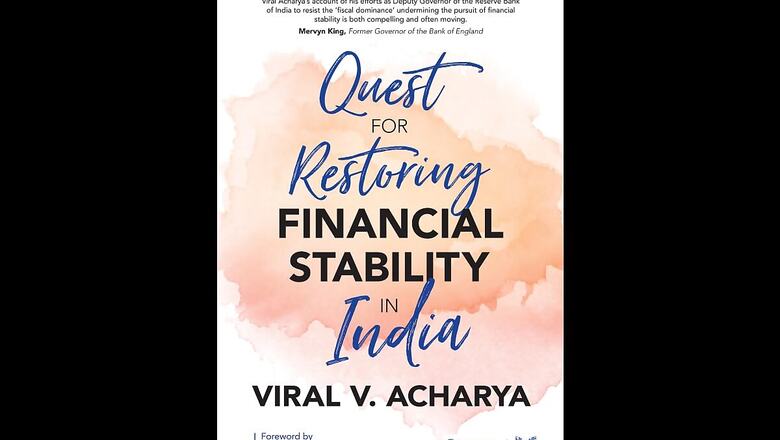
views
Former RBI deputy governor Viral Acharya's latest book, Quest For Restoring Financial Stability In India, uses the Japanese asset price bubble burst of 1992 and the European debt crisis, and their subsequent impacts on the respective banking sectors as lessons for the Indian banking sector, which, according to Acharya is going through a 'silent crisis'.
Acharya returned to the US and re-joined the academia after his sudden resignation from the deputy governor position close to the end of his term in July 2019. His resignation came on the heels of ex-RBI governor Urjit Patel's resignation over the reported disagreement with the government on shift to a market economy from a nationalized system.
In his book, Acharya questions if India can end things differently from Europe and Japan, although the initial situations look 'ominously similar' to their predicaments. The ex-RBI deputy governor writes that on several counts, the issues faced by Japan and Europe were also 'rather similar' too. The book states:
“Both regions (Japan, and Europe) went through a period of severe banking sector stress (although triggered by different causes) and failed to adequately recapitalize their struggling banking sectors. Bank and other stressed balance sheet problems were neither fully recognized nor addressed expediently. In Japan, a likely explanation for the cautious introduction of recapitalization measures is that the authorities were afraid of strong public resistance while announcing large-scale recapitalization, as initial smaller support measures had already caused public outrage. In addition, Japanese officials generally feared sparking a panic in financial markets when disclosing more transparent information about the health of banks.
In Europe, introducing proper recapitalization measures has been challenging due to political circumstances and constraints of the Eurozone. In contrast to a single country like Japan, 19 member states have to come together in the Eurozone and decide on a particular policy measure. In addition, even if a particular policy is helping the Eurozone as a whole, it might not be optimal for each individual country experiencing divergent economic outcomes.
While our initial conditions look ominously similar to these episodes and there are many parallels with how things have played out at our end, we may be fortunate in not having many of these constraints. Hence, I believe we can, we should and in fact, we must do better. We are at a substantially lower per-capita GDP than these countries and a sustained growth slowdown has the potential to really hurt economic prospects of the common man."
In the book, Acharya first turns to consider the positives of the balance sheet resolution agenda that the RBI and the GoI have embarked upon and then highlights the unfinished part of this agenda — its Achilles’ heel — the lack of a clear and concrete plan for restoring PSBs health. He writes:
"To address cross-bank information asymmetry and inconsistencies in asset classification, the RBI created the Central Repository of Information on Large Credits (CRILC) in early 2014. To end the asset classification forbearance for restructured accounts, the RBI announced the AQR from 1 April 2015. The objective was to get the banks to recognize the hitherto masked stress in their balance sheets. The AQR is now complete. The RBI is neither denying the scale of the NPAs nor trying to forbear on them. Instead, it is fully focused on resolving the assets recognized as NPAs.
In the absence of an effective, time-bound statutory resolution framework, various schemes were introduced by the RBI to facilitate viable resolution of stressed assets. While the schemes were designed, and later modified, to address some of the specific issues flagged by various stakeholders in individual deals, the final outcomes have not been too satisfactory. The schemes were cherry-picked by banks to keep loan-loss provisions low rather than to resolve stressed assets. It is in this context that enactment of the IBC in December 2016 can be considered to have significantly changed the rules of the game. It is still early days but the number of bankruptcy cases which have been filed by operational as well as financial creditors is encouraging. Many cases have been admitted and the 180-day clock (extendable by further 90 days) for the resolution of these cases has already started.
The promulgation of the Banking Regulation (Amendment) Ordinance 2017 (since notified as an Act) and the subsequent actions taken thereunder, have made the IBC a lynchpin of the new resolution framework. There were legitimate concerns that if the RBI directs banks to file accounts under the IBC, it would enter the tricky domain of commercial judgments on specific cases. However, the approach recommended by the Internal Advisory Committee (IAC) constituted by the RBI for this purpose has been objective and has allayed these misgivings. The IAC recommended that the RBI should initially focus on stressed assets which are large, material and aged, in that they have eluded a viable resolution plan despite being classified as NPAs for a significant amount of time. Accordingly, the RBI directed banks to file insolvency applications against 12 large accounts comprising about 25 per cent of the total NPAs. The RBI has now advised banks to resolve some of the other accounts by December 2017; if banks fail to put in place a viable resolution plan within the timelines, these cases also will be referred to for resolution under the IBC.
The RBI has also advised banks to make higher provisions for these accounts to be referred under the IBC. This is intended to improve bank provision coverage ratios (see Figure 3.1c) and to ensure that banks are fully protected against likely losses in the resolution process. The higher regulatory minimum provisions should enable banks to focus on what the borrowing company requires to turnaround rather than on narrowly minimizing their own balance sheet impacts. This should also help transition to higher, and more countercyclical, provisioning norms in due course."
The author said that moving forward, RBI hopes that banks use the IBC and file for insolvency proceedings voluntarily, without waiting for regulatory directions.
"Ideally, in line with international best practice, out-of-court restructuring may be the right medicine at ‘pre-default’ stage, as soon as the first signs of incipient stress are evident or when covenants in bank loans are tripped by the borrowers. Once a default happens, the IBC allows for filing for insolvency proceedings, time-bound restructuring and failing that, liquidation. This would provide the sanctity that the payment ‘due date’ deserves and improve credit discipline all around, from bank supply as well as borrower demand standpoints, as borrowers might lose control in IBC to competing bidders."
Acharya adds that although there is a due process for stressed assets to resolve in place, there is no concrete plan in place for PSBs’ balance sheets; how will they withstand the losses during resolution and yet have enough capital buffers to intermediate well to the huge proportion of economy’s savings that they receive as deposits. He asks, can we end the Indian story differently from that of Japan and Europe?
"The GoI has been infusing capital on a regular basis into the PSBs, to enable them to meet regulatory capital requirements and maintain the government stake in the PSBs at a benchmark level (set at 58 per cent in December 2010, but subsequently lowered to 52 per cent in December 2014). In 2015, the Government announced the ‘Indradhanush’ plan to revamp the PSBs. As part of that plan, a programme of capitalization to ensure the PSBs remain BASEL III compliant was also announced. However, given the correctly recognized scale of NPAs in the books of PSBs and the lower internal capital augmentation given their tepid, now almost moribund, credit growth, substantial additional capital infusion is almost surely required. This is necessary even after tapping into other avenues, including the sale of non-core assets, raising of public equity and divestments by the government.
The Cabinet Committee on Economic Affairs has recently authorised an alternative mechanism to take a decision on the divestment in respect of PSBs through exchange-traded funds or other methods subject to the government retaining 52 per cent stake. Synergistic mergers may also be part of the broader scheme of things. The Union Cabinet has also authorized an alternative mechanism for approving amalgamation of PSBs. The framework envisages initiation of merger proposals by the bank boards based on commercial considerations, which will be considered for in-principle approval by the alternative mechanism. This could provide an opportunity to strengthen the balance sheets, management and boards of banks and enable capital raising by the amalgamated entity from the market at better valuations in case synergies eventually materialize.
All of this is good in principle. There are several options on the table and they would have to work together to address various constraints. What worries me however is the glacial pace at which all this is happening. Having embarked on the NPA resolution process, indeed having catalyzed the likely haircuts on banks, can we delay the bank resolution process any further?
Can we articulate a feasible plan to address the massive recapitalization need of banks and publicly announce this plan to provide clarity to investors and restore confidence in the markets about our banking system?
Why aren’t the bank board approvals of public capital raising leading to immediate equity issuances at a time when liquidity chasing stock markets is plentiful? What are the banks’ chairmen waiting for, the elusive improvement in market-to-book which will happen only with a better capital structure and could get impaired by further growth shocks to the economy in the meantime?
Can the government divest its stakes in PSBs right away, to 52 per cent? And, for banks whose losses are so large that divestment to 52 per cent won’t suffice, how do we tackle the issue?
Can the valuable and sizable deposit franchises be sold off to private capital providers so that they can operate as healthy entities rather than be in the intensive care unit under the RBI’s PCA? Can we start with the relatively smaller banks under PCA as test cases for a decisive overhaul?
These questions keep me awake at nights. I fear time is running out. I worry for the small-scale industries that Mr Talwar cared the most about, which are reliant on relationship-based bank credit. The Indradhanush was a good plan, but to end the Indian story differently, we need soon a much more powerful plan—a sudarshan chakra—aimed at swiftly, within months if not weeks, for restoring PSB health, in the current ownership structure or otherwise."

















Comments
0 comment